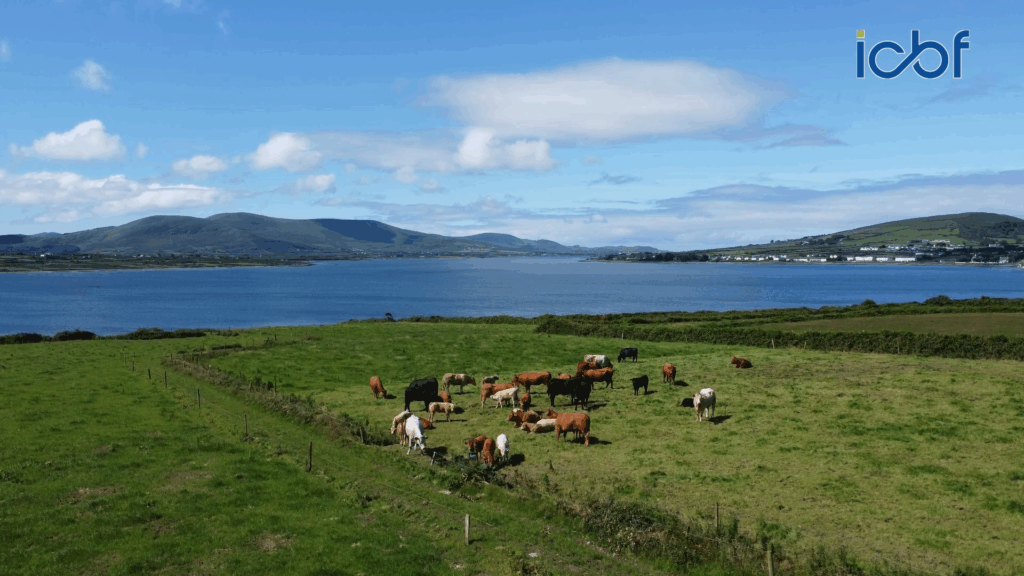Joseph McCrohan, based in Reenard near Caherciveen in Co. Kerry, operates a 20-cow suckler herd made up of Limousin, Saler, and Charolais cross cows.
His system is entirely spring calving, usually beginning in late January and wrapping up by the end of March.
Over the years, Joe has placed strong emphasis on breeding maternal lines, focusing on developing functional, productive suckler cows that are quiet, calve unassisted, fertile, and have ample milk to successfully rear their calves.
Joe has always relied entirely on artificial insemination (AI), as it enables him to select specific bulls for each cow based on her individual strengths and weaknesses. This approach allows him to use maternal sires on cows he wants to breed replacements from, while opting for more terminal bulls on cows he does not intend to keep daughters from.
Choosing Sires
In recent years, Joe has placed greater emphasis on terminal traits when choosing bulls, a strategy that has paid dividends—particularly in the improved quality of his bull weanlings, which he sells each autumn at Iveragh Mart.
Joe explained: “I’m working off the farm, my wife works off the farm, so the amount of time I have is limited enough, so we don’t want any problems with calving.”
Looking at the sires of his 2025 calves, the average Replacement Index of the sires used was €160 and the average Terminal Index was €128 with a carcass weight predicted transmitting ability (PTA) of 24kg. Joe used Limousin, Charolais, and Angus sires.
“I’ve been using maternal sires for the last 10 years, more recently because I’ve had enough of heifers I’ve been using more terminal sires,” Joe said.
“I’m also using sexed semen now to breed replacements.”
To ensure he is getting replacements from his top-performing cows and heifers, Joe has begun using sexed semen on select animals. He selects cows for breeding replacements based on a combination of their Eurostar indexes and their on farm performance. Joe finds AI very manageable, provided there’s good infrastructure in place for handling and separating cows for service. Despite relying entirely on AI, the herd’s fertility performance is excellent, with an average calving interval of 370 days – which places the herd in the top 25% nationally.
Joe joined the DNA registration pilot when it became available in 2020 and has been sampling calves at birth ever since, with no regrets. He said: “I joined the National Genotyping Programme once it came out as a pilot programme and I’ve been in it ever since. It’s a really really good programme.”
The main appeal of genotyping and the National Genotyping Programme (NGP) for Joe was the ability to get more accurate evaluations of his animals at a young age. Within just a few weeks, he receives genomic evaluations, giving him a clear sense of which heifers are most suitable to retain as replacements in his own herd. Each year, Joe also produces a surplus of high-index heifers, which he sells through the local mart.
Myostatin status
Increasingly, farmers are looking at myostatin statuses on their animals as part of their breeding strategy. NGP provides a convenient way of genotyping all the stock in the herd and where possible getting myostatin profiles for these. Farmers can easily view the myostatin and polled status of animals in the herd by logging into their ICBF account and going to “View Profiles” and “Genomics”, where we have introduced a new myostatin and polledness section. Joe is also a participant in the Suckler Carbon Efficiency Programme (SCEP), which requires him to genotype 14 animals each year as part of the scheme.
National Genotyping Programme & SCEP
With 20 cows calving annually, the DNA samples from the first 14 calves fulfil the SCEP genotyping requirement. The cost of genotyping those 14 is covered through his SCEP payment, leaving Joe to pay only for the remaining six calves himself. As a result, participating in the National Genotyping Programme (NGP) costs him just €36 per year to have all his calves genotyped at birth. For Joe, it is an obvious choice—and he believes every farmer should take part in the programme.
“I’d recommend the National Genotyping Programme to every farmer to join it, the sooner you get the information on your calves the better for yourself and it’s easier tag calves – every farmer has to tag their calves anyway,” he said.
Since Joe works full-time off the farm, he aims to keep his system simple and labour-efficient. From this standpoint, taking DNA samples at birth is very convenient because it is done right when the calf is born. Cows calve in individual pens, allowing Joe to tag the calf and collect samples before they leave the pen.
“it’s safer to tag the calves and take the samples at two days-of-age,” he advised.
Additionally, since Joe has some outblocks away from the yard, trying to collect samples from older animals would be more time-consuming and labour-intensive, requiring extra effort to gather and bring them back to the yard for tagging.
There are over 10,200 SCEP herds now signed up to participate in the National Genotyping Programme, which accounts for over 60% of all SCEP herds. For these herds, NGP is a great option and offers the convenience of using double tissue tags and taking samples at birth to meet the genotyping requirements of SCEP. Schemes such as BDGP, SCEP and now NGP have resulted in Ireland having the largest beef genomics database in the world.With over 5 million genotypes now in the ICBF database, 65% of all beef cows and 40% of all dairy cows now genotyped.
The National Genotyping Programme has now reopened for new applicants. Go to www.icbf.com or call the HerdPlus team on 023-8820452 to apply today.


